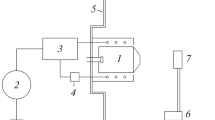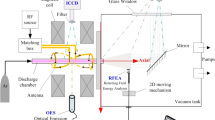Abstract
The spatial distributions of the RF power absorbed by plasma electrons in an ion source operating in the helicon mode (ω ci < ω < ω ce < ω pe ) are studied numerically by using a simplified model of an RF plasma source in an external uniform magnetic field. The parameters of the source used in numerical simulations are determined by the necessity of the simultaneous excitation of two types of waves, helicons and Trivelpiece-Gould modes, for which the corresponding transparency diagrams are used. The numerical simulations are carried out for two values of the working gas (helium) pressure and two values of the discharge chamber length under the assumption that symmetric modes are excited. The parameters of the source correspond to those of the injector of the nuclear scanning microprobe operating at the Institute of Applied Physics, National Academy of Sciences of Ukraine. It is assumed that the mechanism of RF power absorption is based on the acceleration of plasma electrons in the field of a Trivelpiece-Gould mode, which is interrupted by pair collisions of plasma electrons with neutral atoms and ions of the working gas. The simulation results show that the total absorbed RF power at a fixed plasma density depends in a resonant manner on the magnetic field. The resonance is found to become smoother with increasing working gas pressure. The distributions of the absorbed RF power in the discharge chamber are presented. The achievable density of the extracted current is estimated using the Bohm criterion.
Similar content being viewed by others
References
S. M. Mordyk, V. I. Voznyy, V. I. Miroshnichenko, V. E. Storizhko, B. Sulkio-Cleff, and D. Shulha, Nucl. Instrum. Methods Phys. Res. B 231, 37 (2006).
K. P. Shamrai and V. B. Taranov, Plasma Phys. Controlled Fusion 36, 1719 (1994).
A. F. Aleksandrov, N. F. Vorob’ev, E. A. Kral’kina, V. A. Obukhov, and A. A. Rukhadze, Tech. Phys. 39, 1118 (1994).
A. F. Aleksandrov, G. E. Bugrov, K. V. Vavilin, I. F. Kerimova, S. G. Kondranin, E. A. Kral’kina, V. B. Pavlov, V. Yu. Plaksin, and A. A. Rukhadze, Plasma Phys. Rep. 30, 398 (2004).
Ya. B. Fainberg and M. F. Gorbatenko, Sov. Phys. Tech. Phys. 4, 487 (1959).
K. P. Shamrai and V. B. Taranov, Plasma Sources Sci. Technol. 5, 474 (1996).
S. N. Mordik, V. I. Voznyi, V. I. Miroshnichenko, A. G. Nagornyi, D. A. Nagornyi, V. E. Storizhko, and D. P. Shul’ga, Vopr. At. Nauki Tekh., Ser. Plazm. Electron. Novye Metody Uskoreniya, No. 5, 208 (2006).
M. A. Lieberman and A. J. Lichtenberg, Principles of Plasma Discharges and Materials Processing (Wiley, New York, 2005).
Author information
Authors and Affiliations
Corresponding author
Additional information
Original Russian Text © O.V. Aleksenko, V.I. Miroshnichenko, S.N. Mordik, 2014, published in Fizika Plazmy, 2014, Vol. 40, No. 8, pp. 764–770.
Rights and permissions
About this article
Cite this article
Aleksenko, O.V., Miroshnichenko, V.I. & Mordik, S.N. Spatial distribution of the RF power absorbed in a helicon plasma source. Plasma Phys. Rep. 40, 665–671 (2014). https://doi.org/10.1134/S1063780X14080017
Received:
Accepted:
Published:
Issue Date:
DOI: https://doi.org/10.1134/S1063780X14080017




